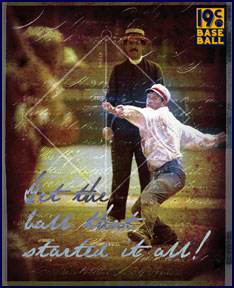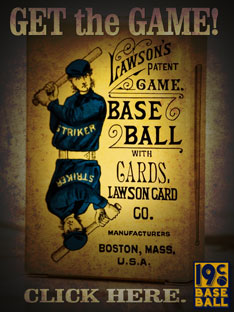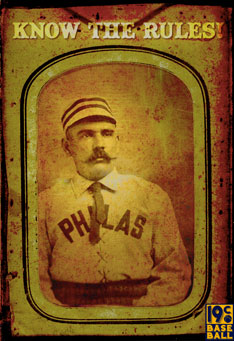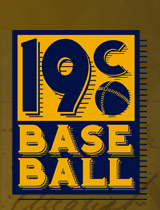The Home Run
By Eric Miklich

ome runs were not common in the 19th century. They were even less common prior to the advent of professional baseball owing to the fact that the balls were mainly hand made and were not consistently hard. Many of the outfields were vast and the game was based on singles and doubles with base runners stealing and taking extra bases.
When the game became more organized and subsequently professional, many times the leaders in the home run category led their league with fewer than 10 for the season. The balls were made more uniformly but the "small-ball" thinking had not changed. In the first professional season in 1871, three players would tie for the lead in the National Association of Professional Base Ball Clubs with four home runs. They were Lip Pike of the Troy Unions (130 at-bats), Fred Treacey of the Chicago White Stockings (124 at-bats) and Levi Meyerle of the Philadelphia Athletics (130 at-bats). Pike had the best home run to at-bat ratio at one homer run every 31 at-bats.
In the National League in 1884, Ned Williamson of the Chicago White Stockings would hit 27 home runs. Only two were hit away from home, both being hit in Buffalo at Olympic Park. Williamson was left-handed batter and it has been stated that the right-field fence at Lake Front Park, Chicago's home field, was less than 200 feet from home plate. This was the shortest fence in the league. Buffalo had the second smallest park in the National League. In fact three other White Stockings hit over 20 home runs that season. Chicago hit 142 for the season which was an unheard of number for the time. No team in either the American Association or the Union Association had more than 40.
Not until the National League and American Association of Base Ball Club written rules, in 1889, was this issue addressed. The rules stated that any fair ball hit out of the field of play less than 210 feet from home base was only a double. The distance was changed to 235 feet for the 1892 season.
No player led the National League with double digit home runs in the 1870s. In the 1880s, 14 players, counting 19 seasons from three leagues, captured the home run title with 10 or more home runs. During the 1890's, only one time did a player lead his league in homeruns with less than 10. That occurred in 1890 in the American Association. In 14 seasons and four leagues in the 1890's, only four times did a player lead the league in home runs with less than 13. Certainly the balls were made better and the hitters were starting to gain an advantage over the pitchers.
Early Home Run Leaders
1871 - National Association of Professional Base Ball Players
Lipman Pike, RF, Troy Unions - 4
Fred Treacey, LF, Chicago White Stockings - 4
Levi Meyerle, 3B, Philadelphia Athletics - 4
1872- National Association of Professional Base Ball Players
Lipman Pike, UT, Baltimore Canaries - 6
1879 - National League of Professional Base Ball Clubs
Charley Jones, LF, Boston Red Caps - 9
1883 - American Association of Base Ball Clubs
Harry Stovey, 1B, Philadelphia Athletics - 14
1884 - National League of Professional Base Ball Clubs
Ned Williamson, 3B, Chicago White Stockings - 27
Many historians and baseball purists dispute Williamson's claim to the 19th century career mark. 19th century base ball expert, author and historian, David Nemec notes in his book The Great Encyclopedia of 19th Century Major League Baseball, "...he hit at least one four-bagger against every first-rate pitcher he faced, including three 300-game winners."
Williamson's mark would not be broken until 1919 when Boston Red Socks leftfielder and pitcher Babe Ruth would hit 29.
Interestingly Ruth was 19 homeruns ahead of the second place finisher. This was the greatest difference between the first and second place finisher to date. In 1899, Washington Nationals right fielder Buck Freeman hit 25 homeruns and the second place finisher, shortstop Bobby Wallace of the St. Louis Perfectos hit 12 and ended up 13 behind Freeman.
According to Mr. Nemec, "Freeman's 1899 season is an extreme outlier. There is no good explanation for it. His home run log shows no particular park effects coming into play. Freeman played for years in the minor during the 1890s and did well but nothing extraordinary. His career after 1899 was a good one but, again, nothing extraordinary."
Freeman began as a pitcher and appeared in 5 games in 1891 and was 3-2 for the Washington Nationals of the American Association. He did not resurface until 1898, with the National League and American Association of Base Ball Clubs' Washington Nationals and appeared in 29 games as an outfielder, hitting just three homeruns. After the 1899 season he never hit more than 13 homeruns for the rest of his career.
Prior to 1891, in the National League, only twice was the difference between the homerun leader and the second place finisher five homeruns, which occurred in 1890 and 1891. The difference was three in 1872 and 1879, and eight times each the difference was two homeruns and nine times the difference was one.
The American Association was a little more erratic. Four times the difference was one homerun, 1884, 1886, 1890 and 1891, three times the difference was four homeruns, 1883, 1887 and 1888, twice the difference was three, 1885 and 1889 and only once the difference was two, in 1882. Both the Union Association, 1884 and the Players' National League, 1890 produced a one homerun difference between the leader and second place in their only seasons.
When the NL absorbed four AA teams for the 1892 season, through the 1899 season, five times one homerun separated the first and second place finisher and once two, 1893 and five, 1898, homeruns were the difference. When the National League was known solely as the National League in 1900, one homerun separated the first and second spot.




